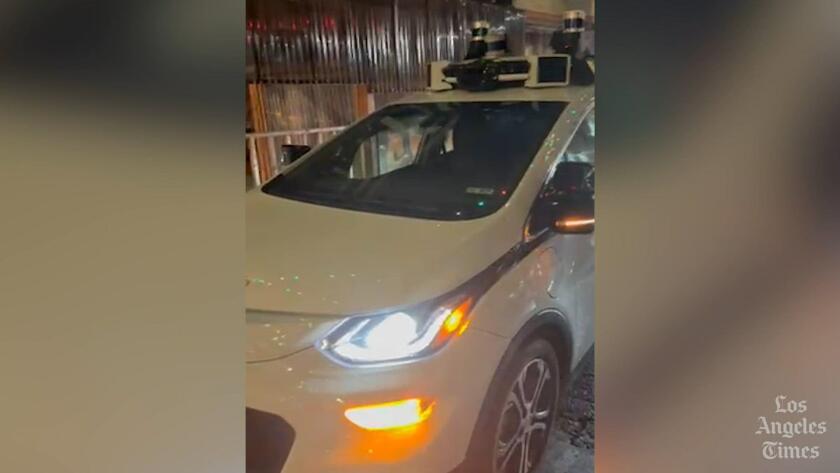One day after California green-lighted a massive expansion of driverless robotaxis in San Francisco, the implications became clear.
At about 11 p.m. Friday, as many as 10 Cruise driverless taxis blocked two narrow streets in the center of the city’s lively North Beach bar and restaurant district. All traffic came to a standstill on Vallejo Street and around two corners on Grant. Human-driven cars sat stuck behind and in between the robotaxis, which might as well have been boulders: no one knew how to move them.
The cars sat motionless with parking lights flashing for 15 minutes, then woke up and moved on, witnesses said.
A pedestrian counts 10 Cruise robotaxis bricked in North Beach late Friday night.
Aaron Peskin, who represents North Beach on the San Francisco Board of Supervisors, fears what could happen when a major fire or other life-threatening emergency breaks out with multiple robotaxis blocking the way. “Our houses in North Beach are made of sticks,” he said. Peskin was flooded with texts, emails and videos from constituents as the robotaxis, programmed with artificial intelligence software, sat unresponsive. In one video, zeroing in on a robotaxi’s “driver” seat, a man says “this is what our country has come to.”
Cruise blamed cellphone carriers for the problem. At 11:01 p.m. Friday, Peskin sent a text message to Cruise government affairs manager Lauren Wilson. At 8:25 a.m. Saturday, she texted back: “As I understand it, outside lands impacted LTE cell connectivity and ability for RA advisors to route cars.” Outside Lands is a three-day music festival held in Golden Gate Park, four miles from North Beach.
The situation is loaded with irony, as the California Public Utilities Commission on Thursday voted 3 to 1 amid great public controversy to allow a massive robotaxi expansion. The vote allows General Motors-owned Cruise and Waymo, owned by Google’s Alphabet, to charge fares for driverless service and grow the fleet as large as they’d like. Cruise has said it plans eventually to deploy thousands of robotaxis in San Francisco.
City officials in San Francisco, from the mayor’s office down, have been fighting the move, with officials saying the robotaxi industry needs to fix problems that endanger the public first before further expanding the business. The city’sFire Department has logged more than 55 cases of robotaxis interfering with first responders. Fire Chief Jeanine Nicholson has repeatedly said Cruise and Waymo are getting in firefighters’ way and their technology is “not ready for prime time.”
The CPUC decided to go ahead anyway. One of the three yes votes was cast by Commissioner John Reynolds, who served as head lawyer at Cruise before appointed to the CPUC by Gov. Gavin Newsom.
The no vote came from Commissioner Genevieve Shiroma, who said the companies should explain the problems and how they plan to fix them first.
North Beach resident Jeffrey Bilbrey observes the line of bricked robotaxis from his apartment window. ‘This is what our country’s come to,’ says a man inspecting a stranded robotaxi.
Peskin said city officials are pursuing “every means” to have the CPUC decision reversed, and are discussing whether to seek a court injunction. Another option: fining Cruise and Waymo thousands of dollars for each robotaxi road blockage.
The CPUC, and Gov. Gavin Newsom, in Peskin’s view, are putting big money ahead of basic public safety. The CPUC “has not been held in high esteem by the people of California for a very long time,” Peskin said. All five CPUC commissioners were appointed by Newsom, including the former Cruise attorney.
“If you’re looking for an example of regulatory capture, you’re seeing it now,” Peskin said. “It’s unethical and immoral but legal,” he said. “Bottom line, this all goes to Gov. Gavin Christopher Newsom.”
Representatives for Newsom and the CPUC could not be immediately reached for comment. In a Twitter post Saturday, Cruise said, “We are actively investigating and working on solutions to keep this from happening again.”



